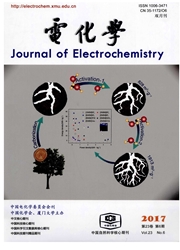

 中文摘要:
中文摘要:
本文通过RDE和EIS联合技术、等效电路模型,研究了酸性体系中商业Pt/C催化剂ORR行为.研究发现Pt/C动态界面包括两个彼此独立的过程:1)Pt表面原有Pt O还原至Pt过程,2)ORR促进新Pt O形成过程,为催化材料稳定性及活化性提供了关键依据;并发现动态界面促进多孔电极重构以及与传输匹配过程.在高过电位下,ORR的高反应速率可通过增加催化材料憎水性予以改善.上述研究结果可对ORR的直流电化学研究进行有效补充,并提供建模基础.
 英文摘要:
英文摘要:
With joint techniques of rotating disc electrode(RDE) and electrochemical impedance spectroscopy(EIS), and further establishment on equivalent circuit model, this paper studied oxygen reduction reaction(ORR) on commercial Pt/C catalyst in acid medium. Our results found that the dynamical interface on Pt/C consists of two independent processes: 1) the Pt O reduction from Pt surface, 2) the new Pt O formation from ORR, thus providing key clues for catalyst stability and activity. This also implied that the dynamical interface facilitates reconstruction for porous electrode, and matches with mass transfer. One important issue is discovered that at high overpotential, the high reaction rate for ORR can be further improved if providing hydrophobicity on catalyst surface. All these efforts on ORR progress not only compensate for DC electrochemistry study, but also provide basis for future model establishment.
 同期刊论文项目
同期刊论文项目
 同项目期刊论文
同项目期刊论文
 期刊信息
期刊信息
